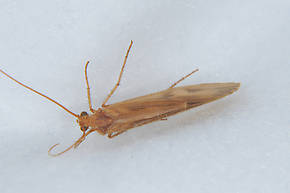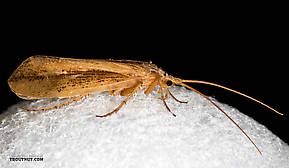Blog & Latest Updates
Fly Fishing Articles
Insects by Common Name


Caddisfly Family Limnephilidae (Northern Caddisflies)
Taxonomic Navigation -?-
Kingdom
Animalia (Animals)
» Phylum
Arthropoda (Arthropods)
» Class
Insecta (Insects)
» Order
Trichoptera (Caddisflies)
» Family Limnephilidae (Northern Caddisflies)
32 genera aren't included.
Common Names
| Match | Common Name |
| Northern Caddisflies | |
| Giant Sedges |
This is page 3 of specimens of Limnephilidae. Visit the main Limnephilidae page for:
- The behavior and habitat of Limnephilidae.
- 1 underwater picture of Limnephilidae.
Pictures of 28 Caddisfly Specimens in the Family Limnephilidae:
Limnephilus (Summer Flier Sedges) Caddisfly Larva View 2 Pictures
View 2 Pictures
 View 2 Pictures
View 2 PicturesCollected January 31, 2004 from unknown in Wisconsin
Added to Troutnut.com by Troutnut on January 25, 2006
Added to Troutnut.com by Troutnut on January 25, 2006
Onocosmoecus unicolor (Great Late-Summer Sedge) Caddisfly Adult View 2 Pictures
View 2 Pictures
 View 2 Pictures
View 2 PicturesCollected October 5, 2011 from the Touchet River in Washington
Added to Troutnut.com by Bnewell on October 11, 2011
Added to Troutnut.com by Bnewell on October 11, 2011
Male Psychoglypha (Snow Sedges) Caddisfly Adult View 2 PicturesThis Psychoglypha adult was found clinging to my garage door in the evening on April 9, 2013. It measures 21 mm in length, from the front of head to the end of wings. It is my hope that Creno will be able to identify it to species based on the image of its genitalia. However, if other images are required for a species ID, the specimen is available, so they can be easily taken. Thanks, Roger Rohrbeck, Mercer Island, WA.
View 2 PicturesThis Psychoglypha adult was found clinging to my garage door in the evening on April 9, 2013. It measures 21 mm in length, from the front of head to the end of wings. It is my hope that Creno will be able to identify it to species based on the image of its genitalia. However, if other images are required for a species ID, the specimen is available, so they can be easily taken. Thanks, Roger Rohrbeck, Mercer Island, WA.
 View 2 PicturesThis Psychoglypha adult was found clinging to my garage door in the evening on April 9, 2013. It measures 21 mm in length, from the front of head to the end of wings. It is my hope that Creno will be able to identify it to species based on the image of its genitalia. However, if other images are required for a species ID, the specimen is available, so they can be easily taken. Thanks, Roger Rohrbeck, Mercer Island, WA.
View 2 PicturesThis Psychoglypha adult was found clinging to my garage door in the evening on April 9, 2013. It measures 21 mm in length, from the front of head to the end of wings. It is my hope that Creno will be able to identify it to species based on the image of its genitalia. However, if other images are required for a species ID, the specimen is available, so they can be easily taken. Thanks, Roger Rohrbeck, Mercer Island, WA.Female Dicosmoecus gilvipes (October Caddis) Caddisfly Adult View 16 PicturesI've been hoping to add a really good October Caddis to the photo collection here for years, but so far I had struck out on finding them on the river. Tonight, this one flew into the kitchen during a pizza party at a house along the river, and was quickly pointed out -- one of the perks of hanging out with other aquatic biologists! Maybe next year I can finally get a salmonfly on taco night or something.
View 16 PicturesI've been hoping to add a really good October Caddis to the photo collection here for years, but so far I had struck out on finding them on the river. Tonight, this one flew into the kitchen during a pizza party at a house along the river, and was quickly pointed out -- one of the perks of hanging out with other aquatic biologists! Maybe next year I can finally get a salmonfly on taco night or something.
 View 16 PicturesI've been hoping to add a really good October Caddis to the photo collection here for years, but so far I had struck out on finding them on the river. Tonight, this one flew into the kitchen during a pizza party at a house along the river, and was quickly pointed out -- one of the perks of hanging out with other aquatic biologists! Maybe next year I can finally get a salmonfly on taco night or something.
View 16 PicturesI've been hoping to add a really good October Caddis to the photo collection here for years, but so far I had struck out on finding them on the river. Tonight, this one flew into the kitchen during a pizza party at a house along the river, and was quickly pointed out -- one of the perks of hanging out with other aquatic biologists! Maybe next year I can finally get a salmonfly on taco night or something.Collected September 29, 2017 from the South Fork Snoqualmie River in Washington
Added to Troutnut.com by Troutnut on September 29, 2017
Added to Troutnut.com by Troutnut on September 29, 2017
Dicosmoecus gilvipes (October Caddis) Caddisfly Adult View 2 Pictures
View 2 Pictures
 View 2 Pictures
View 2 PicturesCollected September 5, 2010 from the Touchet River in Washington
Added to Troutnut.com by Bnewell on June 27, 2011
Added to Troutnut.com by Bnewell on June 27, 2011
Female Limnephilus frijole (Summer Flier Sedge) Caddisfly Adult View 1 Pictures
View 1 Pictures
 View 1 Pictures
View 1 PicturesCollected September 9, 2011 from the Touchet River in Washington
Added to Troutnut.com by Bnewell on September 14, 2011
Added to Troutnut.com by Bnewell on September 14, 2011
Female Hesperophylax designatus (Silver Striped Sedge) Caddisfly Adult View 1 Pictures
View 1 Pictures
 View 1 Pictures
View 1 PicturesCollected September 5, 2011 from the Touchet River in Washington
Added to Troutnut.com by Bnewell on September 14, 2011
Added to Troutnut.com by Bnewell on September 14, 2011
Limnephilus externus (Summer Flier Sedge) Caddisfly Nymph View 1 PicturesThis caddis is one of the most abundant caddisflies in temporary ponds of Glacier Park. The larvae build a round case of detritus (Detritus: Small, loose pieces of decaying organic matter underwater.) and dead plant material that can get quite large.
View 1 PicturesThis caddis is one of the most abundant caddisflies in temporary ponds of Glacier Park. The larvae build a round case of detritus (Detritus: Small, loose pieces of decaying organic matter underwater.) and dead plant material that can get quite large.
 View 1 PicturesThis caddis is one of the most abundant caddisflies in temporary ponds of Glacier Park. The larvae build a round case of detritus (Detritus: Small, loose pieces of decaying organic matter underwater.) and dead plant material that can get quite large.
View 1 PicturesThis caddis is one of the most abundant caddisflies in temporary ponds of Glacier Park. The larvae build a round case of detritus (Detritus: Small, loose pieces of decaying organic matter underwater.) and dead plant material that can get quite large.Collected June 25, 2008 from Temporary ponds- Glacier Nat. Park in Alaska
Added to Troutnut.com by Bnewell on June 26, 2011
Added to Troutnut.com by Bnewell on June 26, 2011
Male Onocosmoecus unicolor (Great Late-Summer Sedge) Caddisfly Adult View 15 PicturesI first just assumed this was Dicosmoecus based on anglers' conventional wisdom since it's a large orange "October caddis," but Creno set me straight. I should have keyed it out. After another look under the microscope, it lacks an anepisternal wart on the mesopleuron (Mesopleuron: The side of the insect mesothorax, and the part to which the fore wings are attached in mayflies.), which rules out Dicosmoecus. The midtibiae have 2 apical (Apical: Close to the apex; tip or end.) spurs and 1 pre-apical (Apical: Close to the apex; tip or end.) spur, and from there the color pattern of the wing points to Onocosmoecus. The location then narrows the species to unicolor.
View 15 PicturesI first just assumed this was Dicosmoecus based on anglers' conventional wisdom since it's a large orange "October caddis," but Creno set me straight. I should have keyed it out. After another look under the microscope, it lacks an anepisternal wart on the mesopleuron (Mesopleuron: The side of the insect mesothorax, and the part to which the fore wings are attached in mayflies.), which rules out Dicosmoecus. The midtibiae have 2 apical (Apical: Close to the apex; tip or end.) spurs and 1 pre-apical (Apical: Close to the apex; tip or end.) spur, and from there the color pattern of the wing points to Onocosmoecus. The location then narrows the species to unicolor.
 View 15 PicturesI first just assumed this was Dicosmoecus based on anglers' conventional wisdom since it's a large orange "October caddis," but Creno set me straight. I should have keyed it out. After another look under the microscope, it lacks an anepisternal wart on the mesopleuron (Mesopleuron: The side of the insect mesothorax, and the part to which the fore wings are attached in mayflies.), which rules out Dicosmoecus. The midtibiae have 2 apical (Apical: Close to the apex; tip or end.) spurs and 1 pre-apical (Apical: Close to the apex; tip or end.) spur, and from there the color pattern of the wing points to Onocosmoecus. The location then narrows the species to unicolor.
View 15 PicturesI first just assumed this was Dicosmoecus based on anglers' conventional wisdom since it's a large orange "October caddis," but Creno set me straight. I should have keyed it out. After another look under the microscope, it lacks an anepisternal wart on the mesopleuron (Mesopleuron: The side of the insect mesothorax, and the part to which the fore wings are attached in mayflies.), which rules out Dicosmoecus. The midtibiae have 2 apical (Apical: Close to the apex; tip or end.) spurs and 1 pre-apical (Apical: Close to the apex; tip or end.) spur, and from there the color pattern of the wing points to Onocosmoecus. The location then narrows the species to unicolor.Collected September 17, 2020 from the Yakima River in Washington
Added to Troutnut.com by Troutnut on September 19, 2020
Added to Troutnut.com by Troutnut on September 19, 2020
Female Grammotaulius lorettae (Northern Caddisfly) Caddisfly Adult View 8 Pictures
View 8 Pictures
 View 8 Pictures
View 8 PicturesCollected August 11, 2018 from the Henry's Fork of the Snake River in Idaho
Added to Troutnut.com by Troutnut on June 12, 2019
Added to Troutnut.com by Troutnut on June 12, 2019
Top 10 Fly Hatches
Top Gift Shop Designs
Eat mayflies.
Top Insect Specimens
Miscellaneous Sites
Troutnut.com is copyright © 2004-2024 Jason
Neuswanger (email Jason). See my FAQ for information about use of my images.
 privacy policy
privacy policy
